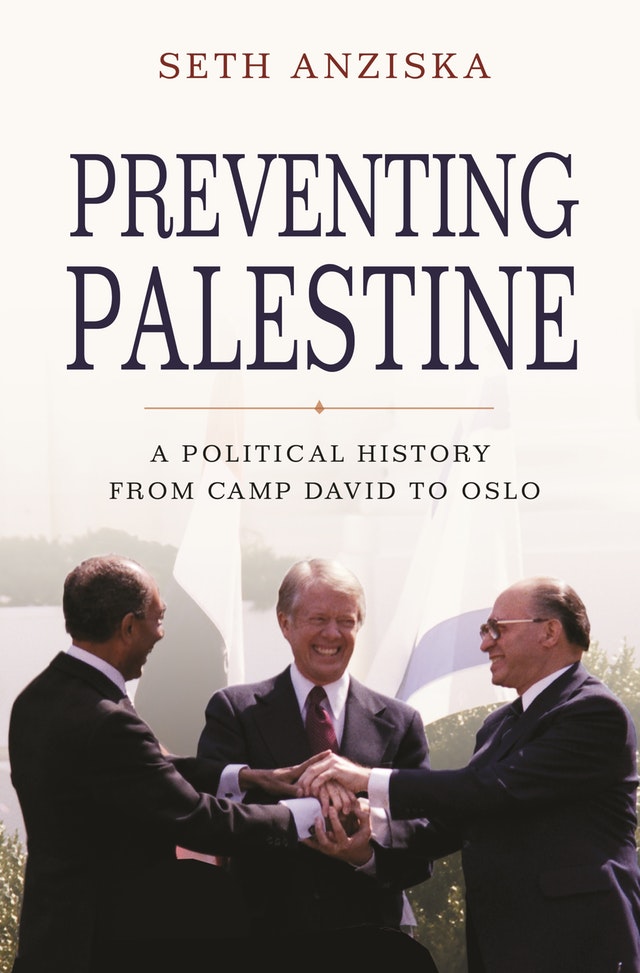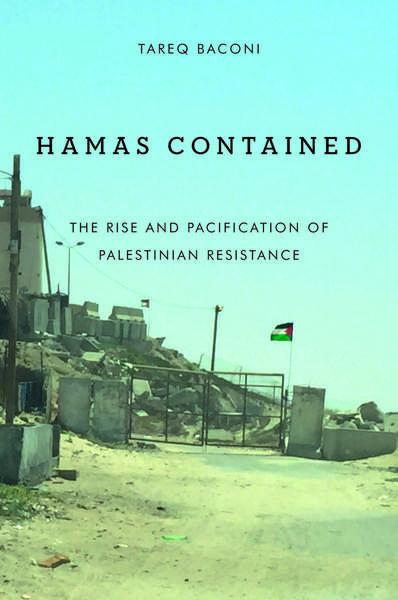By EMILY WHALEN
Review of Preventing Palestine: A Political History from Camp David to Oslo, by Seth Anziska and Hamas Contained: The Rise and Pacification of Palestinian Resistance, by Tareq Baconi
Princeton: Princeton University Press, 2018
Palo Alto: Stanford University Press, 2018
The fundamental belief that security can only come from a state is critical to understanding two new books on Israel and Palestine, Seth Anziska’s Preventing Palestine, and Tareq Baconi’s Hamas Contained. Anziska’s book, a “genealogy of a non-event,” describes the international, multiparty effort that has gone into preventing a resolution to the conflict between Israel and Palestine from 1976 to 1993 (16). Baconi’s book describes the effects of the “endless motion in stillness” that this irresolution generates in what remains of Palestine (xiii). To read these books in succession is to experience a kind of vertigo. Individually, they are critical contributions to English-language scholarship in International History and in Middle Eastern Studies. In tandem, they are like leaning off the crumbling edge of a high cliff.
Leading the reader up the winding hill, Preventing Palestine opens in 1976, with the Jimmy Carter administration’s Herculean efforts to step out of Henry Kissinger’s long shadow. Kissinger’s 1975 commitment to exclude the Palestinian Liberation Organization (PLO) from diplomatic negotiations bound the United States to an “incremental” approach toward peace in the region—and enabled Israel to embark on its own incremental program of settlement in the Palestinian territories. Carter’s tentative efforts to replace incrementalism with a “comprehensive” solution—one that would definitively settle the question of a Palestinian nation-state—withered under the harsh scrutiny of Cold War hawks and the American Jewish community, the latter group having made a critical decision to “support [Israel’s] ruling government at any cost” (87). The election of Israel’s first right-wing government in 1977 and Anwar Sadat’s desperation to secure U.S. patronage eventually led the Carter administration away from a comprehensive solution and toward the Camp David Accords—the triumph of incrementalism.
Anziska draws a straight line from the diplomacy of Camp David to Israel’s 1982 invasion of Lebanon and the First Intifada in 1987. Relying on American and Israeli sources, Preventing Palestine delves into the political vision of Menachim Begin, the rise of neoconservatives under Ronald Reagan, and U.S.-Israeli efforts to cultivate alternatives to the PLO through 1988. A significant part of this narrative traces the successful efforts of Begin and his successors to erase Palestinian sovereignty from the political imagination of the U.S. foreign policy establishment—replacing it with the much vaguer concept of “autonomy”—and to expand Israel’s aggressive settlement program, thereby physically fracturing the remains of the Palestinian state. Whether through excessive credulity, as seen in the Carter and Bush administrations, or outright sympathy, as seen in the Reagan administration, U.S. governments have been amenable to these efforts, Anziska demonstrates, even at the expense of long-term U.S. interests.
Preventing Palestine caused a stir among scholars of the region after its release, in large part because of revelations Anziska uncovered in Israeli archives about U.S. knowledge of the 1982 Sabra and Chatila massacre. Following firmly in the steps of Israel’s New Historians, Anziska reveals Israeli adjacency—and U.S. acquiescence—to the massacre with unflinching succinctness. The book’s admitted limitations are visible in the chapter on Lebanon. Anziska draws a subtle but important distinction between Syrian “involvement” in Lebanon’s civil war, and Israel’s “interventions” in 1978 and 1982, without adequately exploring the continuity between Operation Litani and Operation Peace for Galilee (216-219). Given Israel’s extensive bombing campaigns in South Lebanon from 1970 onward, its longstanding and multiple alliances with right-wing Lebanese Christian militias (including the South Lebanon Army, which operated as an Israeli proxy), and its provocation of other armed groups, including U.S. Marines and UN troops, in Lebanon, Israel’s “intervention” looks a great deal like “involvement” in its civil war. Yet this quibble and other mischaracterizations of Lebanese motivations do not detract from the book’s significant contributions.
As a work of deep research and incisive analysis, Preventing Palestine ably illustrates how diplomacy can perhaps more easily foment competition between “two divergent political projects” than reconcile them (299). Despite its eloquence, the book ends in something of an anticlimax—the “stillborn peace” of the 1993 Oslo Accords, when Israel and the PLO acquiesced to mutual recognition. Climbing the rocky path to international legitimacy, the PLO “sacrificed the basic principles of national self-determination,” and lost its domestic legitimacy (287).
At the top of this precipice, Tareq Baconi’s Hamas Contained tilts the reader’s view forward along Anziska’s narrative arc. The political processes set in motion during the period under study in Preventing Palestine (1976-93) set the stage for Hamas’s rise and its shift “from the military arena into the corridors of government” (xxiii). In some ways a more traditional scholarly monograph than Anziska’s wide-ranging, multi-national chronicle, Hamas Contained explores the growth and transformation of Hamas, the ruling party of the Gaza Strip, from its origins in the First Intifada of 1987 to present day. Dismissed as a “terrorist entity” and as an “Islamist organization,” few studies have ever examined Hamas, as Baconi does, as a “political, not a religious party” (xxi). English-language scholarship on Hamas’s history and political development is fragmentary at best, and ideological at worst. In this context, Baconi’s work, which draws on a broad range of Arabic archives, interviews, and English sources, represents one of the most important books in Middle Eastern studies today.
After a brief first chapter on the origins of Islamist political thought and the Mandatory period in Palestine, Baconi moves swiftly into Hamas’s origins as an offshoot of the Muslim Brotherhood in Palestine during the late 1980s. As the PLO under Yasser Arafat sacrificed Palestinian rights for political accommodation with Israel after 1982, Arafat’s brand of secular, anti-colonial—almost 19th century—nationalism gradually lost its appeal for the Palestinians still living under Israeli occupation. Sheikh Ahmad Yassin articulated an alternative Palestinian nationalism, one that “rose to carry the mantle” of armed struggle as the PLO’s resolve “appeared to wane” (24). After the First Intifada, Hamas’s “rising popularity” in the territories put it on par with the PLO (27). While Arafat’s continual concessions produced no reciprocal compromises (either from the United States or from Israel), Hamas cemented its growing political clout by rejecting the 1993 Oslo Accords—reflecting the sentiments of most Palestinians still living in Palestine. In this context, the Oslo Accords appear in Hamas Contained less as a stillborn peace than a virtually meaningless farce of international proportions that hardly reflected the reality of life in Palestine and Israel.
Hamas Contained continues through the 1990s and 2000s, deftly balancing internal Palestinian politics with the external pressures of the conflict with Israel. Baconi ably demonstrates how easily and urgently outside powers manipulated and interfered in Palestinian national politics. By framing his government’s struggle with Hamas as part of the U.S.-led global “War on Terror,” Benjamin Netanyahu consolidated U.S. support for Likud policies in the occupied territories. As during the Camp David talks and the Oslo Accords, vague language in the aftermath of September 11, 2001 served the political agenda of the Israeli ruling party. Israel’s 2005 “withdrawal” from Gaza, presented to the international community as a concession to Palestinian “autonomy,” was in reality a reconfiguration of Israel’s occupation into “a stifling, externally imposed structure of control” (90). The U.S.-backed “reform” of the PLO after Hamas’s 2006 electoral victory in fact served to retrench Fatah’s centralized power and further undermine the PLO’s legitimacy (101).
Like the PLO, Hamas is a pragmatic organization. Baconi discusses internal debates in the movement over paths to reform and the use of political violence. Much international attention focuses on Hamas’s charter, which lists the destruction of Israel as the party’s central goal. Yet, Baconi explains, most Hamas leaders have demonstrated a willingness to accommodate Israel’s existence in practical, if not rhetorical, terms. Particularly after the Second Intifada in 2002 and the ongoing international blockade of Gaza (which began in 2007), Hamas has proven willing to accept a Palestinian state based on 1967 borders—a concession that amounts to a recognition of Israel’s existence. That Israeli leaders have never accepted these terms speaks both to the rightward shift in Israeli politics, as well as the destructive effects of the “equilibrium of belligerency” between Israel and Hamas (233).
Baconi’s work recalls that of other scholars studying how the pressures of governance shape resistance organizations, such as Rashid Khalidi on PLO decision-making in 1982, Amal Saad-Gohrayeb on Hezbollah in Lebanon, and Jeffrey Byrne on the FLN’s transformation in post-colonial Algeria. Like Khalidi and Byrne, Baconi examines the ways in which party leaders consolidated internal power while fighting an external entity. For example, during Israel’s Operation Protective Edge in 2014, Hamas leaders took advantage of the “chaotic environment of war” to “settle political scores and carry out extrajudicial assassinations of its domestic enemies,” which included prisoners and suspected informants (217). While framing itself as the representative of the Palestinian people, Hamas “produced a totalitarian order under its rule in Gaza,” whereby residents were not subject to harassment by Israeli soldiers, but neither were they permitted the freedom of political dissent (213-214).
Baconi charges Hamas with much responsibility for the fractured state of Palestinian politics in the territories today, but focuses only on the split between the West Bank and Gaza. This is only one cleavage in the Palestinian community. The rise of Hamas also signaled the end of an era in the relationship between the Palestinian diaspora and Palestinians still living in the territories. Particularly because of Hamas’s commitment to the right of return, Baconi’s decision not to focus on this dimension of Palestinian politics is disappointing. Nevertheless, Hamas Contained remains essential reading for scholars of the Middle East, of U.S. foreign policy, and of nationalism in the 21st century.
What lies under Anziska and Baconi’s cliff? In its current form, a final resolution to the conflict between Israel and Palestine seems unlikely. Both authors write about the ineluctable clash of fundamental political divergences, with a mixture of informed cynicism and quixotic hope that scholars of the region will find familiar. Yet peaceful resolution would require a transformation of political will in Israel and of political capacity in Palestine—and a sudden upsurge of political courage among U.S. policymakers. Perhaps instead, the edge of the cliff overlooks a different dilemma, one that touches on the fundamental divergence both Anziska and Baconi describe: not of Israel versus Palestine, nor of Islamism versus secularism, but rather, that of political compromise versus ideological intransigence.
Posted on 23 October 2019
EMILY WHALEN is an Ernest May Predoctoral Fellow at Harvard Kennedy School's Belfer Center and a doctoral candidate at the University of Texas at Austin, where she studies the history of U.S. foreign policy in the Middle East.


